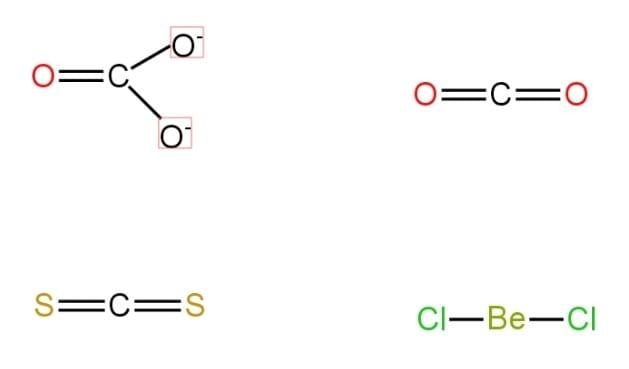
Which of the following is a non-linear molecule?
(A) $C{{O}_{3}}^{2-}$
(B) $C{{O}_{2}}$
(C) $C{{S}_{2}}$
(D) $BeC{{l}_{2}}$
Answer
218.7k+ views
Hint: Firstly, the hybridization of each of the molecules in the options is determined. The hybridization is calculated by calculating the number of bond pairs and lone pairs in a molecule. Hybridization is the idea of combining the two atomic orbitals to form a new type of hybridised orbital. This mixing creates hybrid orbitals with entirely different energies and shapes.
Formula Used: Hybridization is calculated as:
Hybridization=$12(V+M-C+A)$
Where $V$= number of valence electrons of the central atom
$M$= number of monovalent atoms
$C$= positive charge
$A$= negative charge
Complete Step by Step Answer:
(A) $C{{O}_{3}}^{2-}$
Hybridization=$\frac{1}{2}(4+0-0+2)=3$
The hybridization of $C{{O}_{3}}^{2-}$is$s{{p}^{2}}$. Hence, $C{{O}_{3}}^{2-}$is non-linear in shape.
(B) $C{{O}_{2}}$
Hybridization=$\frac{1}{2}(4+0-0+0)=2$
The hybridization of $C{{O}_{2}}$is$sp$. Hence, $C{{O}_{2}}$is linear in shape.
(C) $C{{S}_{2}}$
Hybridization=$\frac{1}{2}(4+0-0+0)=2$
The hybridization of $C{{S}_{2}}$is$sp$. Hence, $C{{S}_{2}}$is linear in shape.
(D) $BeC{{l}_{2}}$
Hybridization=$\frac{1}{2}(2+2-0+0)=2$
The hybridization of $BeC{{l}_{2}}$is$sp$. Hence, $BeC{{l}_{2}}$is linear in shape.
All the other molecules in the options except $C{{O}_{3}}^{2-}$are $sp$ hybridised and thus, linear in shape.
The structures of all the molecules are shown below:

Thus, $C{{O}_{3}}^{2-}$is a non-linear molecule.
Correct Option: (A) $C{{O}_{3}}^{2-}$.
Note: The central atom in the geometry described by linear molecular geometry is bonded to two other atoms (or ligands) at a bond angle of${{180}^{o}}$. All the linear molecules must be $sp$ hybridized. Non-linear molecules have bond angles other than ${{180}^{o}}$, depending upon the shape of the molecule. The shape of the molecule may be bent, trigonal planar, tetrahedral, trigonal bipyramidal, etc.
Formula Used: Hybridization is calculated as:
Hybridization=$12(V+M-C+A)$
Where $V$= number of valence electrons of the central atom
$M$= number of monovalent atoms
$C$= positive charge
$A$= negative charge
Complete Step by Step Answer:
(A) $C{{O}_{3}}^{2-}$
Hybridization=$\frac{1}{2}(4+0-0+2)=3$
The hybridization of $C{{O}_{3}}^{2-}$is$s{{p}^{2}}$. Hence, $C{{O}_{3}}^{2-}$is non-linear in shape.
(B) $C{{O}_{2}}$
Hybridization=$\frac{1}{2}(4+0-0+0)=2$
The hybridization of $C{{O}_{2}}$is$sp$. Hence, $C{{O}_{2}}$is linear in shape.
(C) $C{{S}_{2}}$
Hybridization=$\frac{1}{2}(4+0-0+0)=2$
The hybridization of $C{{S}_{2}}$is$sp$. Hence, $C{{S}_{2}}$is linear in shape.
(D) $BeC{{l}_{2}}$
Hybridization=$\frac{1}{2}(2+2-0+0)=2$
The hybridization of $BeC{{l}_{2}}$is$sp$. Hence, $BeC{{l}_{2}}$is linear in shape.
All the other molecules in the options except $C{{O}_{3}}^{2-}$are $sp$ hybridised and thus, linear in shape.
The structures of all the molecules are shown below:

Thus, $C{{O}_{3}}^{2-}$is a non-linear molecule.
Correct Option: (A) $C{{O}_{3}}^{2-}$.
Note: The central atom in the geometry described by linear molecular geometry is bonded to two other atoms (or ligands) at a bond angle of${{180}^{o}}$. All the linear molecules must be $sp$ hybridized. Non-linear molecules have bond angles other than ${{180}^{o}}$, depending upon the shape of the molecule. The shape of the molecule may be bent, trigonal planar, tetrahedral, trigonal bipyramidal, etc.
Recently Updated Pages
Is PPh3 a strong ligand class 12 chemistry JEE_Main

Full name of DDT is A 111trichloro22bispchlorophenyl class 12 chemistry JEE_Main

Sodium acetate on heating with soda lime produce A class 12 chemistry JEE_Main

Find the isoelectric point pI of Lysine A 556 B 974 class 12 chemistry JEE_Main

The order of basicity among the following compounds class 12 chemistry JEE_Main

The number of isomers in C4H10O are a7 b8 c6 d5 class 12 chemistry JEE_Main

Trending doubts
JEE Main 2026: Application Form Open, Exam Dates, Syllabus, Eligibility & Question Papers

Derivation of Equation of Trajectory Explained for Students

Hybridisation in Chemistry – Concept, Types & Applications

Understanding the Angle of Deviation in a Prism

Understanding Collisions: Types and Examples for Students

Understanding Atomic Structure for Beginners

Other Pages
NCERT Solutions For Class 12 Chemistry Chapter 1 Solutions - 2025-26

NCERT Solutions for Class 12 Chemistry Chapter Chapter 7 Alcohol Phenol and Ether

NCERT Solutions ForClass 12 Chemistry Chapter Chapter 8 Aldehydes Ketones And Carboxylic Acids

JEE Advanced Marks vs Ranks 2025: Understanding Category-wise Qualifying Marks and Previous Year Cut-offs

Haloalkanes and Haloarenes Class 12 Chemistry Chapter 6 CBSE Notes - 2025-26

Solutions Class 12 Chemistry Chapter 1 CBSE Notes - 2025-26




